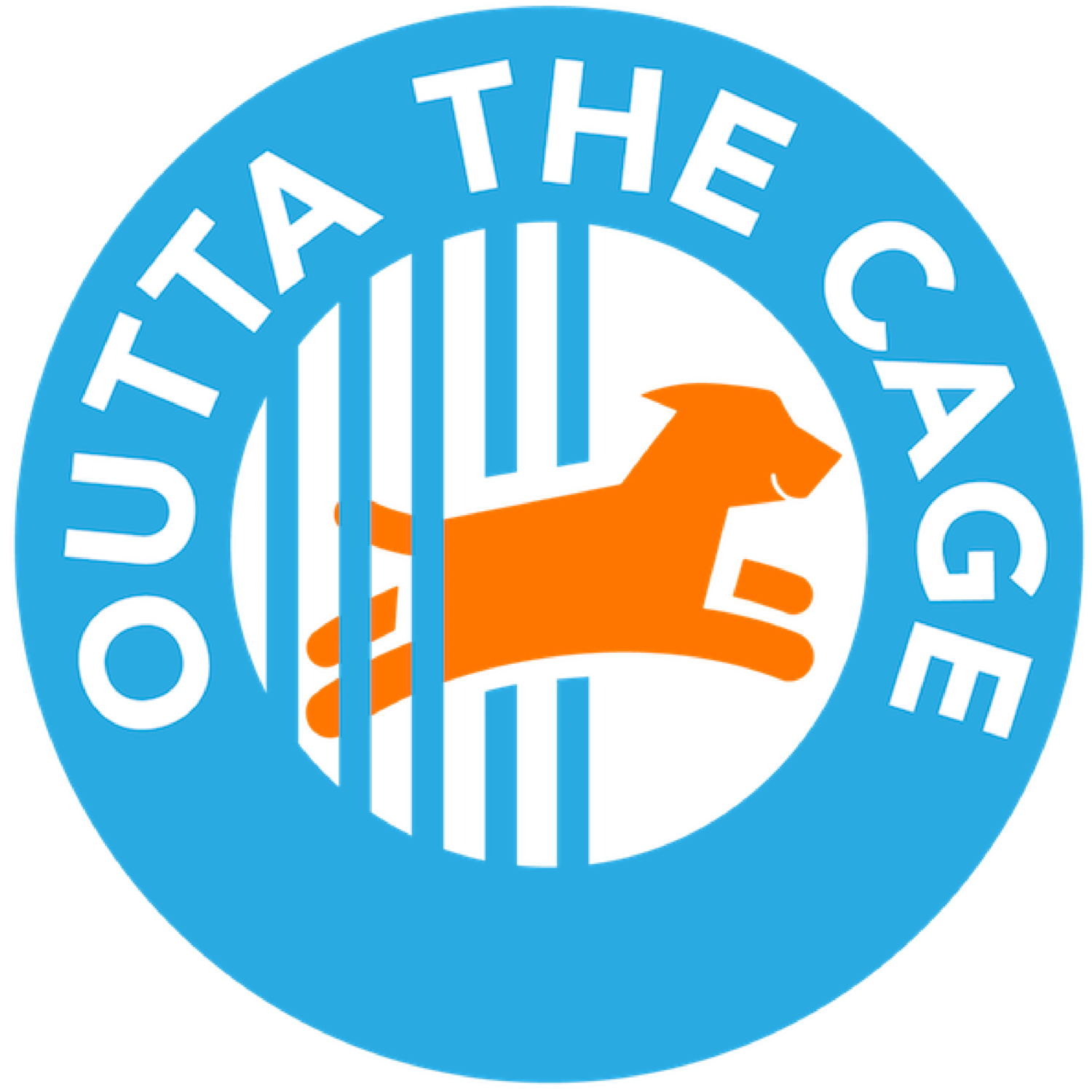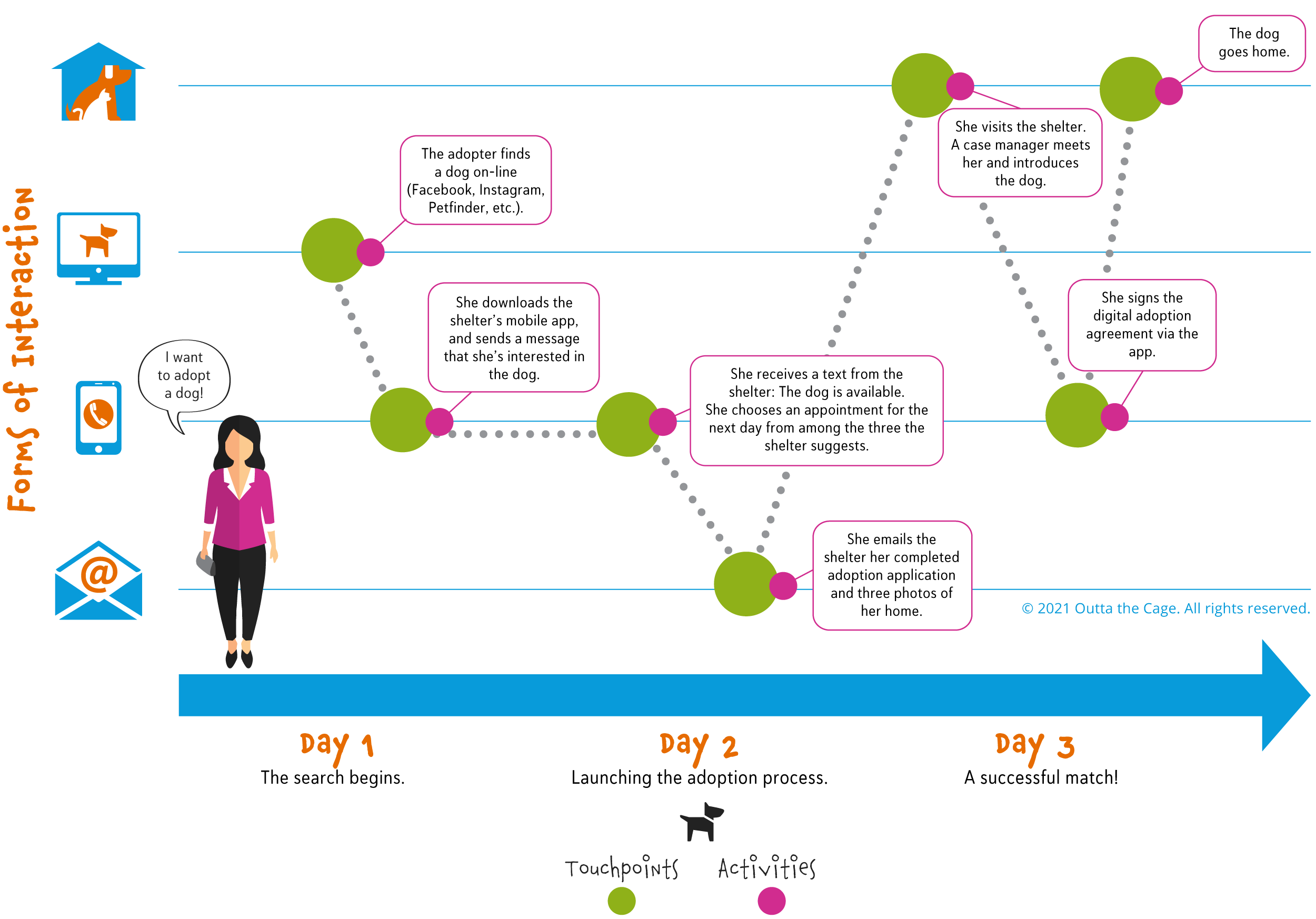Community-based Sheltering in a Post-COVID World: An online ebook

SECTION 3.
Using technology for good saves lives.
“It’s not the notes you play. It’s the notes you don’t play.”
Miles Davis, American jazz trumpeter
Making humans wait risks lives. Humans wait on hold to find out more about a shelter animal. They wait for someone to email them an adoption form. They wait for an appointment to meet a dog or cat. They wait while that animal is spayed, neutered, or vaccinated. And they wait in line for myriad reasons. Like the phenomenon of “abandoned shopping cart” in the retail world, even when people want something, they have a patience threshold.
Remember the tale of two shelters in Section 1? Paper-intensive business processes, outdated infrastructure, misguided policies, a lack of constituent connection, and poor leadership can actually impede adoptions. Shelters that use new technologies to accelerate processes and eliminate inefficiencies are saving more lives.
Let’s start with the adopter’s journey.
The adopter in our first adopter’s journey diagram waited 12 days to adopt a dog—and still ended up disappointed. Here’s what that could look like:
This improved journey drastically reduces the time and effort an adopter must endure to bring her new dog home. It could be even faster if the adopter were offered a virtual visit—i.e., meeting a dog or cat with the help of a shelter volunteer and a web cam—then picking him up curbside the same day.
Thanks to digitization, adopters can find a shelter pet with an app on their phones, enabling them to monitor shelter notes, track how many visitors have expressed interest in the animal, and know if there’s any adoption interest. Shelters could open access to the animal’s data to rescuers and other community members, sparking the “network effect” as people share the dog’s information and word spreads. This would also remedy the backlog of callers waiting on hold to inquire about lost or adoptable animals.
Empowering the community with a self-service shelter app is a great start. The human time saved could be reallocated to caring for animals or to introducing foster, food bank, or low-income support programs. Staff could also be reallocated and retrained to enter additional data about the animals in their care, thereby increasing the collective knowledge about each one.
It’s not just the technology. Shelters need to be data-driven, too.
Technology for saving more animal lives isn’t limited to smartphone apps and digital screens. Shelters can benefit from modern technology tools to better understand their own performance, increase efficiencies, improve community outreach, and yes, even reduce liability risks.
Most public shelters are accountable to the public agencies that govern them. This means providing these agencies with information, including:
number of animals entering the shelter by time period (day, week, month, year);
number of animals leaving the shelter by time period and how they left (adopted, rescued, euthanized, or transported); and
intakes by breed, age, or condition of the animal.
These are relatively straightforward reports. But often they are error-prone, use heavily summarized data, and rely on specialized skills to produce. The systems that generate these reports might be homegrown or based on older systems. They’re not easy to decipher and the data they use might be incorrect.
The clincher? The information in the reports isn’t actionable.
☙ BIZ BYTES ❧
Corporations have adopted data and analytics technologies to learn how to better serve customers, promote products, increase margins, decrease operating expenses, and lure a distractible consumer audience into their stores, branches, and clinics.
Analytics tools allow business people to ask questions based on available data—for instance, how many new customers did we acquire last month versus the same month in the prior year?—and get answers that are easy-to-read, often in the form of graphical dashboards or scorecards.
As data grows and business people become more sophisticated, they can evolve to using artificial intelligence tools that will not only answer their questions, but guide them in taking optimal action. For instance: Here is the customer segment who is more likely to purchase Product x with a discount code.
Here are some opportunities for the expanded use of data in the animal welfare community that could save lives:
Opportunity #1: Cluster intake data.
Data could show intake rates by geographic region, breed, and intake type (found as a stray, owner surrender, etc.). Analysis of this data could identify geographic or demographic “clusters” that might inform concentrations of backyard breeders, repeat adopters, or even hoarders. Such data could also be used by law enforcement or goodwill organizations, resulting in deployment of mobile spay and neuter clinics to high-surrender neighborhoods, the creation of local foster registries, or transfers of animals from highly-populated shelters to facilities with available kennels.
Opportunity #2: Measure partner effectiveness.
Shelters do their best to work with partner organizations to save sick, senior, stressed, or other animals deemed unadoptable. Assessing the effectiveness of these partnerships is paper-intensive, arduous, and difficult to maintain. Some rescue organizations become defunct before they ever save an animal, but nevertheless “stay on the books.” Some shelter partners send cats out, but never take cats in. Despite these relationships, shelters needing to find urgent placements often end up tapping the same small set of partners again and again.
Robust analytics would allow shelters to not only analyze histories for specific partners, it would reveal rescue frequency, breed preferences, dog return rates, complaint histories, and adoption success rates. Such analysis could lead to partner profiles, allowing shelters to target the organizations most likely to rehabilitate and place a given animal. This could save countless hours and countless lives.
Opportunity #3: Leverage mobile apps for disaster response.
Natural disasters and climate-related events are dire for humans and animals. Organizations like Best Friends Animal Society and the ASPCA have launched programs to ensure that during these events, animals can be brought to safety and reunited with their families. Real-time weather apps can track the path of a hurricane. Teams on the ground can pinpoint the most at-risk communities, proactively taking family pets to safety. Microchip scanners can immediately identify an animal and where it lives. And lost and found programs, such as FindingRover.com or PetFBI.com, can help owners find their missing pets faster than ever before.
Opportunity #4: Factor in artificial intelligence.
In the business world, companies that have been collecting a rich history of customer, sales, and marketing data have a head start using advanced technologies like artificial intelligence (AI). AI technologies not only provide answers to questions—for instance, how many neo-natal kittens did we take in from March through June—but what to do about the answer. AI that mimics human reasoning, simply speaking, could provide recommendations to help the rescue community be proactive in avoiding problems before they occur. Likewise, sophisticated imaging, natural language (English-like requests), and pattern recognition algorithms can solve problems that were heretofore impossible.
Here are some AI examples:
Sending mobile spay and neuter clinics to neighborhoods likely to have a preponderance of community cats in advance of kitten season.
Deploying skills on smart home voice assistants such as Amazon Alexa and Google Home that allow people to receive real-time status. “Alexa, which shelters within 50 miles have adoptable reptiles?”
Tracking the probable rate and pattern of disease outbreak within and between shelters, boarding kennels, and other places where animals are concentrated.
Helping an adopter find a dog that looks like the dog they grew up with.
Pushing cute photos of adoptable cats to your mother, who gets sad when she scrolls through the shelter’s website.
Municipal shelters that fall under a common governmental oversight umbrella might operate independently with no lens into how their fellow shelters are doing. By not only analyzing their data but sharing it, these shelters could pinpoint loopholes, drive new efficiencies, and test out more effective outreach scenarios.
For instance, why has one shelter nearly doubled its number of private adoptions while another shelter a mere 9 miles away reports increasing euthanasia rates? By sharing and comparing detailed data and reports, shelters could teach and learn from each other, share resources, transfer animals to one another based on kennel availability and visitor traffic, and add intervention services like keeping pets with their families.
Data sharing also extends to external data. Many shelters require rescue partners to share their data with the shelter to remain in good standing. Dallas Animal Services even shares its data-driven performance dashboard externally, thus encouraging members of the public to participate in lifesaving programs.
Some independent networkers, rescue organizations, software vendors, and members of the public who volunteer keep their own data. For instance, Outta the Cage maintains statistics on the dogs we video at shelters, including how long the dog was in the shelter, the dog’s energy level, the reason the dog entered the shelter, the length of time between being videoed and making it out, and the number of dogs that didn’t make it. The following three charts show examples of what the Outta the Cage data has revealed.
This bar chart won’t surprise anyone who’s visited a shelter recently. The reason that pit bulls are the breed type most often adopted, rescued, or euthanized is simply that they are, by far, the most common breed type populating shelters across North America. Of all the dogs euthanized in shelters, an estimated 40% are pit bull type dogs. [source]
The tree map above tells a different story. While the vast majority of the dogs in this shelter are pit bulls, most of the dogs that actually enter the shelter are not purebred pit bulls (if there even is such a thing), but rather mixed breed dogs who have been labeled “pit bull mix.”
Often this distinction is made at the whim of a harried shelter worker who thinks every dog is a pit bull. This is a missed opportunity to accurately label an otherwise adoptable dog. Indeed, many shelters are now using more inclusive “breed type” designations, as adoption rates actually increase when breed types aren’t included.
For additional reading on breed labels:
A PLOS research study was published September 2020: A label’s a label, no matter the dog: Evaluating the generalizability of the removal of breed labels from adoption cards
PEOPLE reported on the PLOS study: Dogs Get Adopted Faster When Shelters Don’t Include Dog's Breed on Adoption Profile, Study Finds
The chart above shows the number of days between the date a dog was videotaped at the shelter and the date it was adopted. There is a clear correlation between videotaping a dog and posting that video on social media and its likelihood of being adopted or rescued. Our data shows that the average number of days a pit bull type dog with a video is adopted is 54 percent higher than if the dog had not been videoed.
What would change if shelters could get this kind of information on demand? What types of decisions could shelter workers make? Though our Outta the Cage data shows that dogs who are videotaped have a 92% higher likelihood of making it out of the shelter alive, we still find ourselves pleading with shelter managers to let us come video at-risk dogs.
Even before Covid-19, the technology community was stepping up. New applications and platforms are emerging to address a host of issues. Mobile devices and apps are offering rich, real-time information about adoptable animals. Social media is cultivating awareness of animals who would otherwise go unseen.
Digital and cloud solutions are eliminating paperwork, reducing backlogs, and automating manual processes, rendering paper-based liability waivers and behavior records obsolete, and offloading time-intensive system maintenance. New tools to streamline the search, fostering, adoption, lost and found, and networking processes are increasing by the day. And the community has begun to use them.




